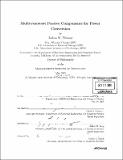| dc.contributor.advisor | David J. Perreault and Jeffrey H. Lang. | en_US |
| dc.contributor.author | Phinney, Joshua W. (Joshua William), 1973- | en_US |
| dc.contributor.other | Massachusetts Institute of Technology. Dept. of Electrical Engineering and Computer Science. | en_US |
| dc.date.accessioned | 2006-08-25T18:51:43Z | |
| dc.date.available | 2006-08-25T18:51:43Z | |
| dc.date.copyright | 2005 | en_US |
| dc.date.issued | 2005 | en_US |
| dc.identifier.uri | http://hdl.handle.net/1721.1/33859 | |
| dc.description | Thesis (Ph. D.)--Massachusetts Institute of Technology, Dept. of Electrical Engineering and Computer Science, 2005. | en_US |
| dc.description | Includes bibliographical references (p. 199-202). | en_US |
| dc.description.abstract | Semiconductor-device limitations to system miniaturization have receded, but exposed by their improvement numerous "ancillary" barriers which continue to preoccupy nearly every electronics industry. Prominent among these obstacles are package parasitics and heat, which have come to the fore as conventional circuits are applied in modern regimes of frequency and integration density. To an ever increasing extent, integration limits are symptoms of the fundamental frequency- and size-scaling limits of passive components. Power inductors and transformers, in particular, are challenging to miniaturize because of their poor performance when scaled down in size, and the difficulty of fabricating them with available planar processes. A family of approximating networks for transmission lines, the focus of this work, enables miniaturization by internally circulating energy and exchanging delay fidelity for bulk energy storage. These multi-resonant components are substantially smaller than their lumped counterparts, in particular requiring less inductance, and enforce useful waveform symmetries that can be traded for higher power or higher efficiency. | en_US |
| dc.description.abstract | Lumped analogs of transmission lines, and delay-based means of processing energy in general, exploit rather than fight the parasitics which can restrict conventional designs to lower switching frequencies, and are compatible with RF power-conversion techniques. Printed-circuit and wafer- or package-scale construction methods for multi-resonant structures are presented, along with power-converter topologies that exploit the waveform symmetries they enforce. A new soft-switched RF power converter is introduced, in particular, that demonstrates reductions in peak device stress and passive-component size. Taken together, the construction techniques, networks, and converter topologies presented here extend the power levels and applications for which passive components can be manufactured in an integrated fashion, within a printed circuit board or at the die/package scale alongside semiconductor switches and converter controls. | en_US |
| dc.description.statementofresponsibility | by Joshua W. Phinney. | en_US |
| dc.format.extent | 202 p. | en_US |
| dc.format.extent | 10783248 bytes | |
| dc.format.extent | 10791746 bytes | |
| dc.format.mimetype | application/pdf | |
| dc.format.mimetype | application/pdf | |
| dc.language.iso | eng | en_US |
| dc.publisher | Massachusetts Institute of Technology | en_US |
| dc.rights | M.I.T. theses are protected by copyright. They may be viewed from this source for any purpose, but reproduction or distribution in any format is prohibited without written permission. See provided URL for inquiries about permission. | en_US |
| dc.rights.uri | http://dspace.mit.edu/handle/1721.1/7582 | |
| dc.subject | Electrical Engineering and Computer Science. | en_US |
| dc.title | Multi-resonant passive components for power conversion | en_US |
| dc.type | Thesis | en_US |
| dc.description.degree | Ph.D. | en_US |
| dc.contributor.department | Massachusetts Institute of Technology. Department of Electrical Engineering and Computer Science | |
| dc.identifier.oclc | 66278622 | en_US |
